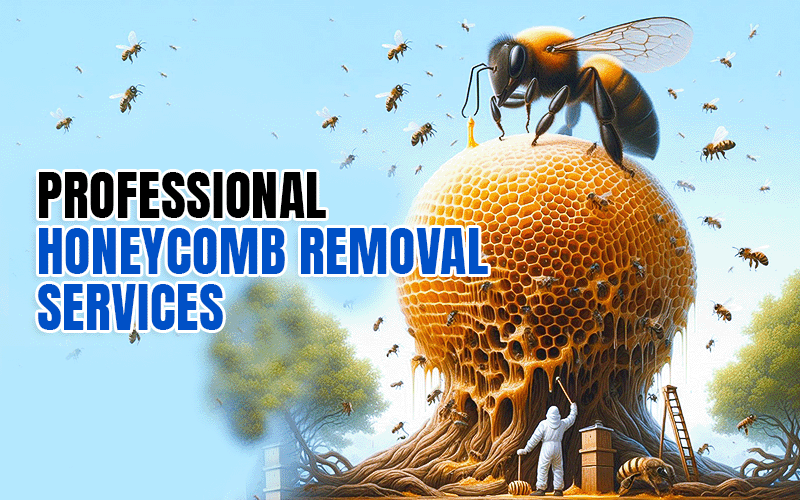HoneyComb Removal Services
Professional HoneyComb Removal Services: Safe and Effective Removal
- Pest_Control

If you have unwanted bees around your home, it’s crucial to handle the situation carefully. Contact Blue Diamond Honey Bee Control Services, a local beekeeper, who can safely remove the bees without harming them. Honeybees, known for their honey production, are essential pollinators. They create honey from the pollen and nectar of the plants they pollinate, storing it in honeycombs to nourish their larvae throughout the winter months
Table of Contents
Understanding Honeybees
Honeybees are unique among social insects for maintaining long-lasting colonies. They often build nests in tree crevices, but they can also nest in attics or chimneys. While honeybees do sting, they only sting once. A bee sting can be very painful, and those allergic to insect bites may experience severe reactions. Bee colonies near homes can become defensive and more likely to sting.
Why Professional Management is Essential
Managing or removing a beehive, along with its honey, can be messy and challenging. Due to the size of honeybee colonies, only a professional or experienced beekeeper should handle honeybee removal. Getting too close to a bee nest can provoke them, making professional intervention necessary. Pest control technicians with proper training and equipment can safely and effectively remove a bee’s nest.
Locating and Treating Bee Nests
Bee nests can sometimes be located by tapping the wall and listening for a buzz. Once the nest is found, a hole is drilled, preferably through the outside wall, to apply insecticide. Avoid plugging the hole immediately after treatment, as it may force bees into the home. The best time to eliminate established swarms is in late winter when their numbers are low. Applying insecticide in the late afternoon when all bees are home ensures maximum effectiveness.
Post-Removal Cleanup
After eliminating the bees, it’s essential to remove the nest to prevent issues like melting wax, infestations from wax moth larvae, or leaking honey, which can stain walls. Bees from other colonies may be attracted to the remaining honey, causing further problems. Scavenger insects like carpet beetles can also be drawn to dead bee hives.

Preventing Future Infestations
Once the colony is removed and structural repairs are made, seal all entry points to prevent new swarms from entering. Older homes with cracks in walls or under eaves are particularly vulnerable. Plugging or screening these holes before bee swarming season can prevent new colonies from establishing. The odors from a previous colony can linger and attract other swarming bees, so thorough sealing is essential.
Contact Blue Diamond for Honey Bee Control Services
For safe and effective bee removal, trust Blue Diamond for Honeycomb Control Services. Our professional team ensures your home is free from bee infestations, protecting both your family and the bees.
FAQs for Professional Honeycomb Removal Services
Why is it important to handle honeybee removal professionally?
Professional management is crucial due to the size and defensive nature of honeybee colonies. Only trained professionals or experienced beekeepers should handle the removal to ensure safety and effectiveness.
How can I locate a bee nest in my home?
Bee nests can sometimes be located by tapping the wall and listening for a buzzing sound. If a nest is found, professionals will drill a hole to apply insecticide safely and effectively.
What is the best time to eliminate a bee swarm?
The best time to eliminate established swarms is in late winter when their numbers are low. Applying insecticide in the late afternoon when all bees are home ensures maximum effectiveness.
What should be done after bees are removed?
Post-removal, it is essential to remove the nest to prevent issues like melting wax, infestations from wax moth larvae, or leaking honey. Proper cleanup ensures no residual problems attract other insects or bees.
How can I prevent future bee infestations in my home?
To prevent future infestations, seal all entry points after removing the colony and making structural repairs. Older homes with cracks in walls or under eaves are particularly vulnerable, so plugging or screening these holes is crucial.
Share this
Book Your
Service In
30 Seconds
- 29 years of experinece
- Served 40,000+ clients across UAE
- Dubai Municipality Approved
- Eco - friendly products safe for All
- Cost Effective
- 24/7 Customer support
Check out our Recent Blogs
The Importance of Regular Pest Inspections for Your Property
Frequently Asked Questions (FAQs) Introduction Importance is at the core of every decision a responsible property owner makes, especially when...
How Technology Is Transforming the Pest Control Industry
Introduction In recent years, technology has reshaped nearly every industry — and pest control is no exception. What was once...



